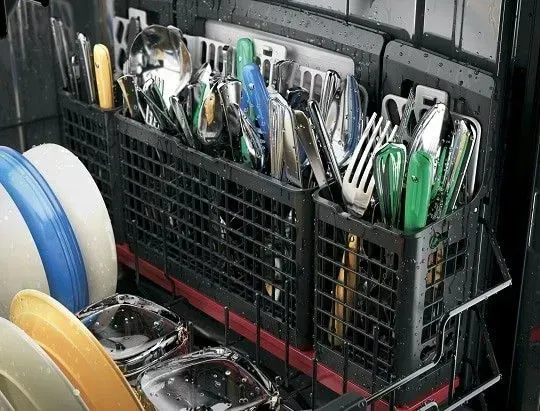How to Load a GE Dishwasher for Better Cleaning Results
GE dishwashers are among the industry’s best models thanks to high-tech features and powerful cleaning performance. Like all dishwashers though, they need to be loaded correctly in order to get dishes as clean as possible. That’s why learning how to load a GE dishwasher is crucial for getting the most out of your model.

Here’s How to Load a GE Dishwasher Properly…
You can sometimes find dishwasher loading instructions in your GE dishwasher manual, but these dishwasher loading tips are useful no matter which model you own. We’ll take things one section at a time so you can maximize cleaning efficiency and still-dirty dishes.
Cutlery Basket
Start by loading your forks, spoons, knives, and other utensils. Unlike most other dishwasher models, GE designs their silverware baskets so you can load all cutlery head-down for safety. This helps to avoid cutting yourself on knives or forks that are facing upward. Items like spoons or forks can still be loaded head-up though to improve spacing.
The real key for how to load a GE dishwasher silverware basket is to space items evenly and avoid stacking. Having forks or spoons nested together prevents water from reaching every surface, resulting in sub-par cleaning. Space your cutlery evenly, and mix different items together for best results.
Adjustable Silverware Basket
Some newer GE models use a modular silverware basket. This clever design can be adjusted, broken into sections, or even placed in the top rack for more space on bottom. If your model has this option, be sure to follow the same loading instructions no matter where you decide to place the basket.
Upper Dishrack
The top rack is the ideal place for items like cups, glasses, bowls, longer utensils, and dishwasher-safe plastics. Proper placement is most important for how to load a dishwasher upper rack. Items should always face down and be angled toward the center. This allows water from the spray arm to reach every surface, but ensure nothing obstructs it from spinning freely.
Maximize your dishwasher’s cleaning ability by loading shallow items on the outside of the top rack, and deeper items on the inside. You can also use the outer rows to lay long utensils like whisks or ladles down flat since they most likely won’t fit in the silverware basket. And if you need more space up top, use the rack adjusters on either side to change the height of the rack.
Lower Dishrack
The last step for how to load a GE dishwasher is arranging items in the bottom rack. As you can imagine, this is where you’ll load your larger dishes like plates, pots, pans, casserole dishes, and more. Thin pieces like platters should go along the outside, and bulky items like bowls or casseroles can use the corners.
All dishes on the lower rack should be facing down toward the spray arm and tilted at an inward angle. Just be sure to avoid overloading with too many dishes in one load. This can block water from reaching every surface and leave behind stuck-on food particles.
How Not to Load a Dishwasher
We’ve already gone over the dangers of overcrowding and stacking like items together, but what about pre-rinsing dishes? That seems important, right?
Wrong! The magic of modern science means that dishwasher detergents actually work better when dishes have some food left on them. Just scrape off any large food chunks before loading, then let the enzymes within the detergent do the rest!
Now that you know how to load a GE dishwasher properly, you can enjoy the cleanest dishes you’ve ever had! If you still find that your model isn’t cleaning well though, call the dishwasher repair service professionals at Reliable Appliance Service. We’ll diagnose the problem and have your unit running like new again in no time.

